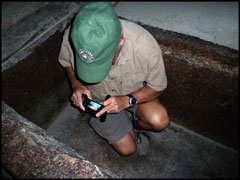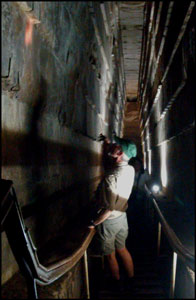|
Tom Ross writes: |
The article below is in response to a theory put forth about Egyptian drilling techniques in the video above. |
|
Egyptian Drilling
by
Tom Ross Copper mines were not found in Egypt till around Djoser's time. In the 3-4 dynasties it is believed that the Egyptians mined about 4 tons (8000 pounds) per year. Egyptian drill bits found ranged in size from .25 inches to 5 inches diameter. They ranged in thickness up to 1/5 of an inch. Thus a 2” hole drill with 1/5” wall thickness 4’ long would weigh over 6 pounds. So in the time period of the 3-4 dynasties they could produce over 1300 of these bits per year. If that was all they made with the copper, which we know it not accurate.
For me to drill granite I would use water assisted electric core drill with a diamond cutting head. [See this at NEWS page, Jan 17th - video of drilling in the Red Pyramid] On average we can cut 1’ in depth with 3000 revolutions of the drill (with mild pressure applied to the bit) twenty 4’ deep holes is a common life for a bit used in this fashion. A hand operated core drill could be rotated at possibly 60 revolutions per min. The cutting ability is affected by the cutting agent. Dune sand is a poor choice. Dune sand had rounded edges caused by the way it is created. I would say it had less than 20% of the cutting abilities of diamonds. Thus the 3000 revolutions would increase to 15,000 revolutions per inch equaling 4+ hours per inch of Egyptian style drilling. With a common size sarcophagus requiring over 55 thousand inches of drilling. With one crew drilling it would take 25 years at 7 days a week 24 hours a day. While drilling the drill casing is wearing out due to the cutting agent rubbing between the hole and the side of the drill. Modern core drills address this with water. The water lubricates the bit and flushes out the material between the casing and the side of the hole. My thoughts are that the copper drills used would wear out at about a 15% ratio of the holes drilled. Meaning you will need 8250 inches of drill to drill out 55,000 inches of hole. This translates to 4,200 pounds of copper. A six month supply of all Egypt’s copper to drill out one Sarcophagus.
Information obtained from Advanced Machining in Ancient Egypt by Christopher P. Dunn. And from http://www.theglobaleducationproject.org/egypt/articles/hrdfact1.php Comments?
Send an email
and we will forward it to Tom. Facebook members can comment on the
posting:
http://www.facebook.com/1worldtours |








